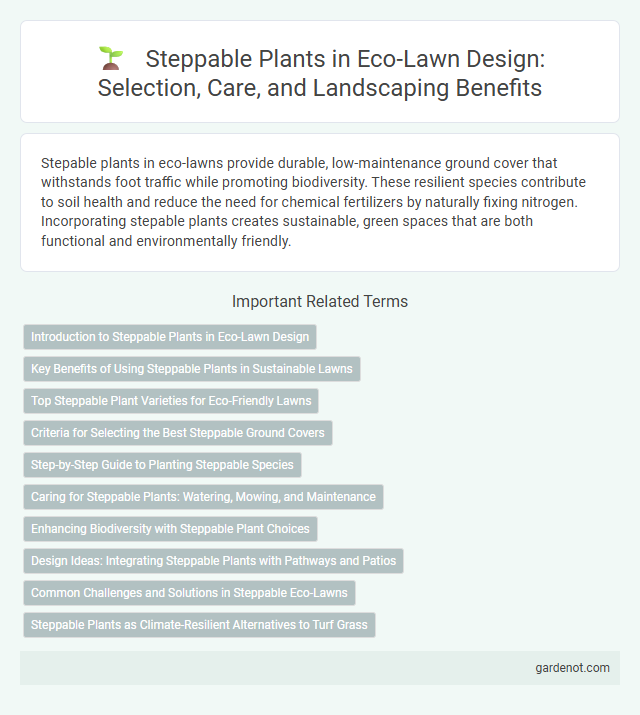Stepable plants in eco-lawns provide durable, low-maintenance ground cover that withstands foot traffic while promoting biodiversity. These resilient species contribute to soil health and reduce the need for chemical fertilizers by naturally fixing nitrogen. Incorporating stepable plants creates sustainable, green spaces that are both functional and environmentally friendly.
Introduction to Steppable Plants in Eco-Lawn Design
Steppable plants in eco-lawn design are low-growing, resilient plant species that withstand foot traffic while maintaining green coverage and soil health. These plants enhance biodiversity, reduce water consumption, and improve soil aeration compared to traditional grasses. Common steppable species include clover, creeping thyme, and Irish moss, which create sustainable and attractive groundcovers for eco-friendly landscaping.
Key Benefits of Using Steppable Plants in Sustainable Lawns
Steppable plants such as clover, thyme, and moss enhance eco-lawns by providing durability and resilience under foot traffic, reducing soil erosion, and improving soil health through nitrogen fixation. These plants require less water, fertilizer, and mowing compared to traditional grass, contributing to lower maintenance costs and a reduced environmental footprint. Their dense, ground-covering nature supports biodiversity and helps retain moisture, fostering a sustainable and visually appealing lawn.
Top Steppable Plant Varieties for Eco-Friendly Lawns
Top steppable plant varieties for eco-friendly lawns include Creeping Thyme, known for its low growth and aromatic foliage, and Irish Moss, which forms a dense, soft carpet ideal for light foot traffic. Other popular options are Corsican Mint, offering resilience and a pleasant scent, and Blue Star Creeper, valued for its tiny star-shaped flowers and durability. These plants contribute to sustainable landscaping by reducing water usage and eliminating the need for chemical treatments.
Criteria for Selecting the Best Steppable Ground Covers
The best steppable ground covers for eco-lawns combine durability, low maintenance, and aesthetic appeal, thriving under foot traffic without soil compaction or erosion. Ideal plants exhibit fast recovery rates, drought tolerance, and shallow root systems that stabilize the soil while allowing water penetration. Species such as creeping thyme, Irish moss, and white clover meet these criteria, providing green coverage that withstands regular foot traffic and contributes to sustainable landscaping.
Step-by-Step Guide to Planting Steppable Species
Planting steppable species requires selecting hardy, low-growing plants such as creeping thyme, Irish moss, or chamomile, known for their durability and aesthetic appeal in eco-lawns. Prepare the soil by loosening it and ensuring proper drainage to support root development, then sow seeds or transplant plugs evenly across the designated area. Maintain consistent moisture during establishment, avoid heavy foot traffic until plants are well-rooted, and apply organic mulch to retain soil moisture and suppress weeds.
Caring for Steppable Plants: Watering, Mowing, and Maintenance
Steppable plants, commonly used in eco-lawns, thrive with careful watering that keeps the soil consistently moist but not waterlogged to promote healthy root growth. Mowing should be frequent and at a moderate height to encourage dense, durable turf capable of withstanding foot traffic. Regular maintenance includes removing weeds and aerating the soil to enhance air circulation and nutrient absorption, ensuring a robust, sustainable green space.
Enhancing Biodiversity with Steppable Plant Choices
Steppable plants such as clover, creeping thyme, and Irish moss enhance biodiversity by providing habitat and food sources for pollinators and beneficial insects within eco-lawns. These resilient species tolerate foot traffic while supporting soil health through nitrogen fixation and moisture retention. Integrating diverse steppable plants fosters a robust, sustainable lawn ecosystem that promotes ecological balance and reduces the need for chemical inputs.
Design Ideas: Integrating Steppable Plants with Pathways and Patios
Stepable plants such as creeping thyme and Irish moss create durable, low-maintenance groundcovers ideal for eco-lawns, seamlessly blending with pathways and patios. Integrating these plants into stone or gravel walkways enhances soil stabilization while promoting biodiversity through pollinator-friendly flowers. Utilizing steppable plants in design not only adds aesthetic texture and greenery but also reduces urban heat island effects by minimizing hardscape surfaces.
Common Challenges and Solutions in Steppable Eco-Lawns
Common challenges in steppable eco-lawns include soil compaction, uneven surface wear, and poor drainage, which hinder plant growth and durability. Solutions involve selecting resilient stepable plants such as clover and creeping thyme, improving soil aeration through regular tilling, and installing permeable substrates to enhance water drainage. Proper maintenance practices like controlled foot traffic and periodic reseeding also promote a healthy, sustainable eco-lawn.
Steppable Plants as Climate-Resilient Alternatives to Turf Grass
Steppable plants such as Creeping Thyme, Irish Moss, and Corsican Mint offer climate-resilient alternatives to traditional turf grass by thriving under foot traffic while requiring less water and maintenance. These plants improve soil health through natural aeration and support biodiversity by attracting pollinators, which enhances ecosystem stability. Their deep root systems improve drought resistance and carbon sequestration, making them ideal for sustainable landscaping in eco-lawns.
Stepable plant Infographic

 gardenot.com
gardenot.com